 SOLOMON LUNGER
.
August 31, 2023
.
F100 Builders
SOLOMON LUNGER
.
August 31, 2023
.
F100 Builders

In the wonderful world of “hot rodding” most do not just buy any ol’ truck and call it done. There is always a deeper meaning behind it for each and every owner.
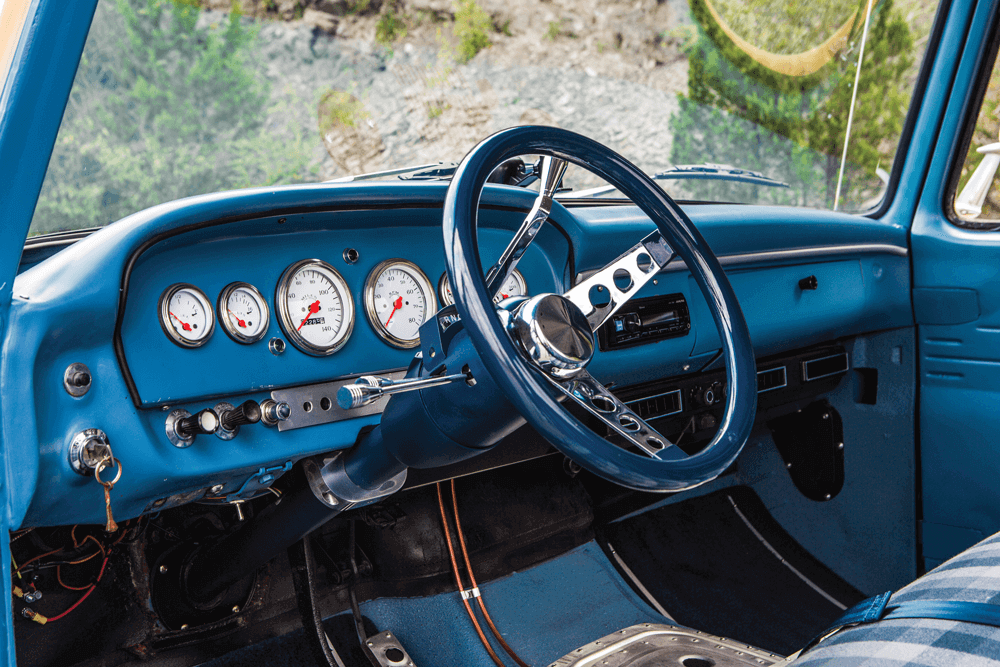
Larry Shirley of Aiken, South Carolina, is no exception. Coming from a long line of hot rodders, his father was a pinstriper and airbrush artist, and his grandfather was a good ol’ wrench-turning grease monkey. His veins were filled with the spirit of hot rodding from an early age, so it’s no surprise that Larry has jumped into these pages.

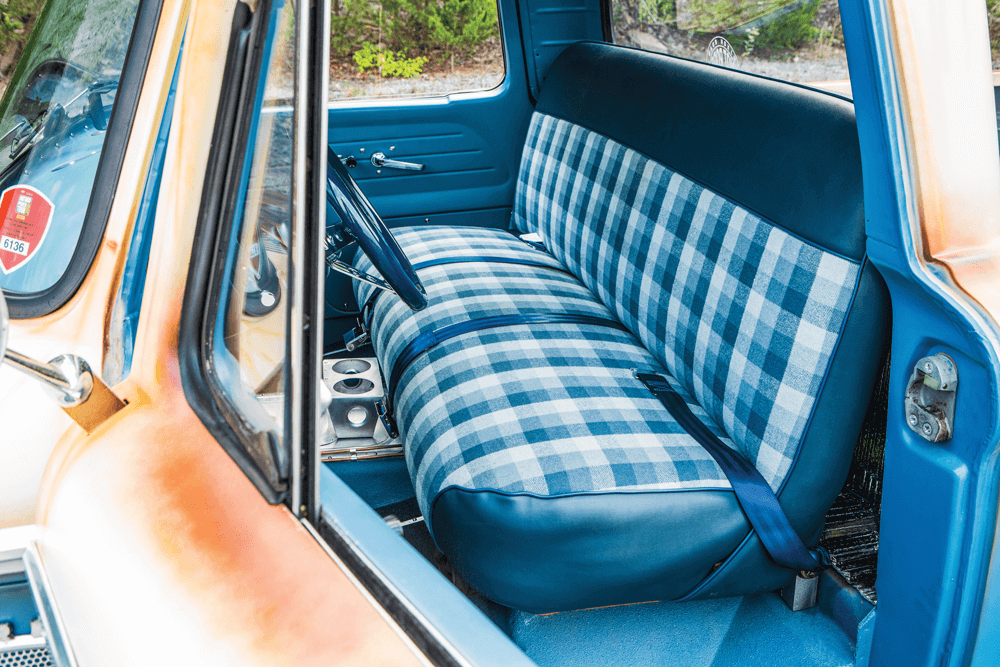
Having built a Model A Sedan, a ’70 Pontiac GTO and countless other hot rods, Larry was no stranger to the custom automotive industry as a whole. But he wanted to step out of his comfort zone and do something a little different with this build. The truck build was truly a family affair getting help from his wife Venera and daughter Victoria, brother in-law Doug and his buddy Joey Caudle, all helping to keep the spirit of hot rodding alive through family tradition and garage builds.
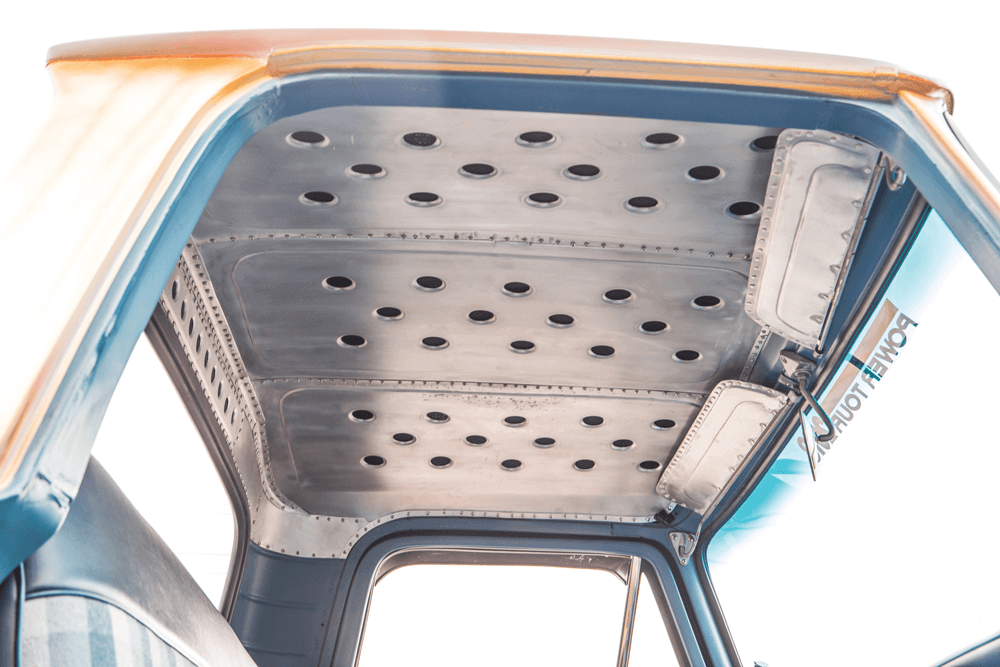
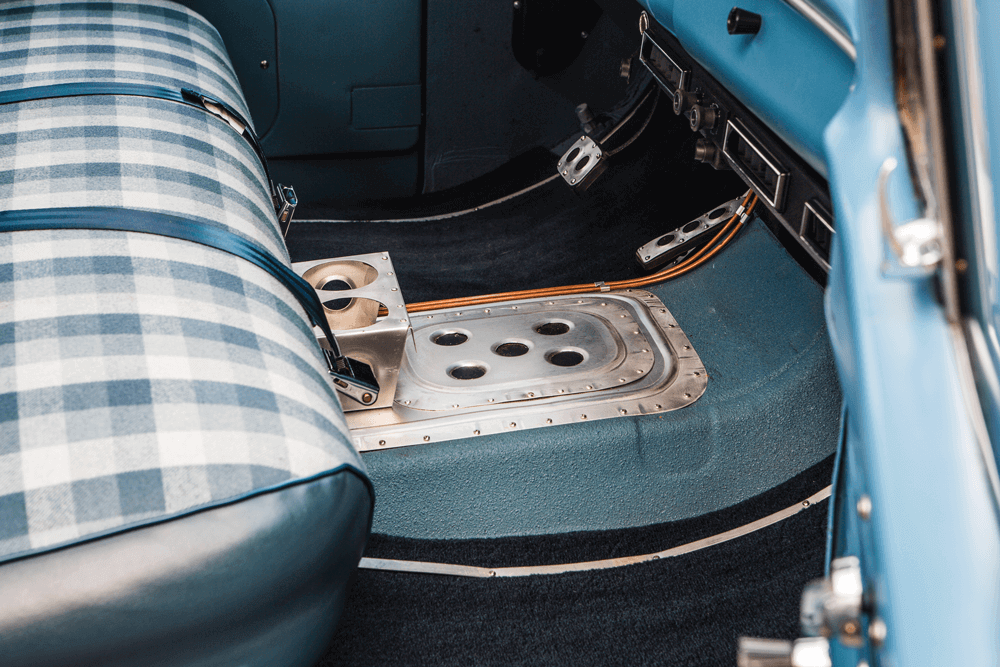
Moonlighting as an automotive paint rep, Larry is all about the deep shine and vibrant colors. On this project he wanted to go out of the box and way out of his element. He started scouring his local newspaper classifieds and online classifieds to find the right project truck and settled on this 1966 Ford F-100. He said when he went to look at the truck, the previous owner just painted everything with a rattle can. The interior, exterior, all the brightwork, everything. He knew that he could bring the truck back to its former glory and his vision started to come to life.



Larry got the truck back to his home shop. The initial plans were to do a mild refresh of the truck. He was looking for a patinaed truck, something he called “wash and wear,” but being on the East Coast most things were just too rusty. He really liked the look of patina and, being an artist, he thought he might be able to recreate the perfect look. Never before has he tried to airbrush rust or weathering, but there’s a first time for everything! Being a paint rep has its perks. He had just removed a paint setup to replace it with an all new lineup. Instead of throwing out and wasting all of the older paint, Larry made what he calls a “bucket mix.” He had this great fabric he bought long before the truck and knew it would be the perfect color combo, so he went with a white and blue two tone.
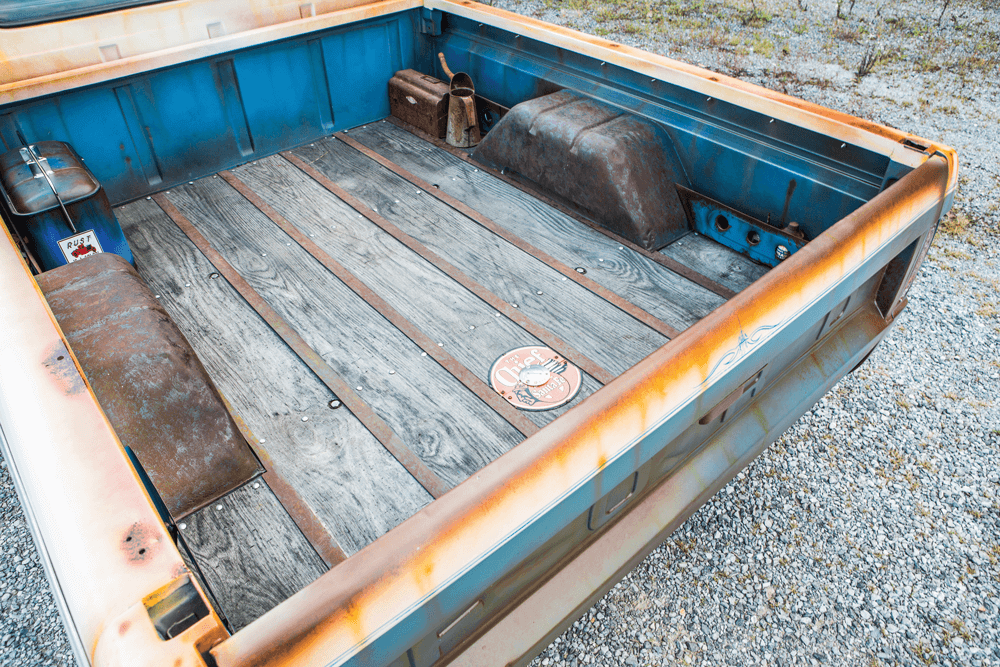
Most nights, once finishing his “Honey-Do” list, he would have time to go out to his garage and work on his ’66 little by little. He began laying down his base coat colors and going back and forth adding and layering with his airbrush.
“It’s a very therapeutic feeling to have no direction and just let the art make itself,” Larry says.
After dialing in the paint and getting to a point where he was pleased with the outcome, he began to tear into the rest of the truck.
He knew he wanted a lowered stance, but he weighed all the options. With the cost of dropped I-beams and all the extra parts it would take but knowing it would still drive like an old truck, Larry decided to put in a ’04 Crown Vic IFS. It gave him all of the modern comforts and luxuries while getting the stance how he wanted it: a bit closer to Mother Earth. Out back, he also upgraded to a ’99 Crown Vic 8.8 rear end, which is narrower than the ’04 so he could fit some wider wheels/tires. Retaining the leaf springs but going for a more condensed spring rate got the rear sitting a bit lower as well.
 Working on his old truck became a great way to unwind from work, and he just kept going and adding unique features like custom sheet metal work in the interior and bed. It was a way of showing off his skills and building the truck he had envisioned in his mind. The F-100 was now really taking shape and he was trying to find a power plant for the truck. He knew that he wanted to really drive the truck both near and far. He initially was looking to put in a Coyote 5.0 but unfortunately the budget just wouldn’t allow it. He ended up swapping in a nicely worked 351 Windsor out of an ’84 F-150 to stay budget friendly but still pack a punch.
Working on his old truck became a great way to unwind from work, and he just kept going and adding unique features like custom sheet metal work in the interior and bed. It was a way of showing off his skills and building the truck he had envisioned in his mind. The F-100 was now really taking shape and he was trying to find a power plant for the truck. He knew that he wanted to really drive the truck both near and far. He initially was looking to put in a Coyote 5.0 but unfortunately the budget just wouldn’t allow it. He ended up swapping in a nicely worked 351 Windsor out of an ’84 F-150 to stay budget friendly but still pack a punch.

Larry admits one of the things he finds cool about the truck is maintaining Ford Motor Company parts for all of the upgrades, including the brake booster and master cylinder off a ’90s Mustang. Everything just worked out so well with little modification or headache (which you definitely don’t hear very often!).
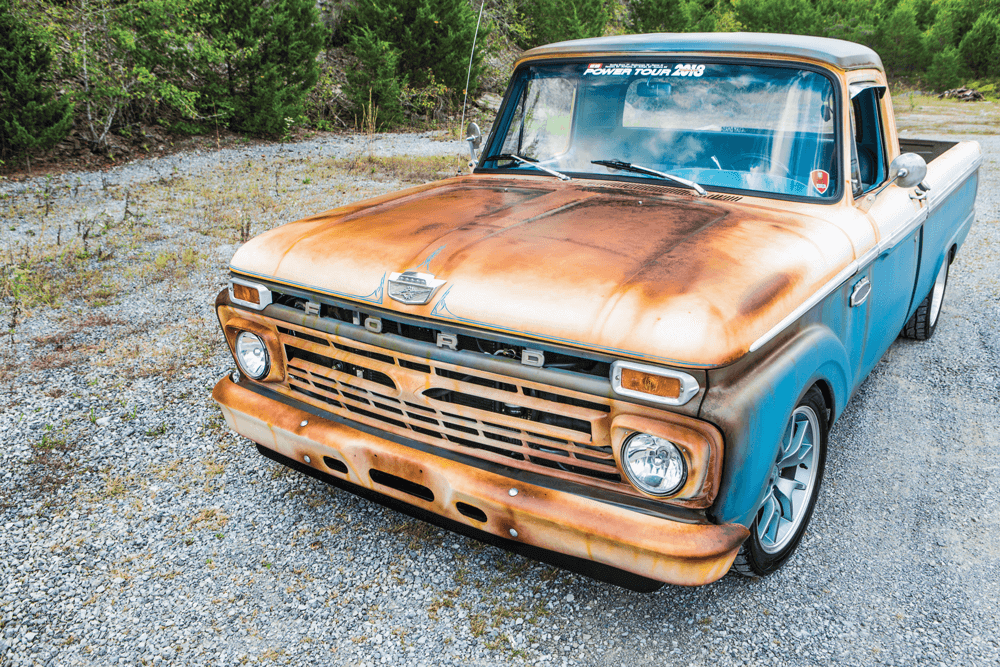
We think the best thing about this build is that Larry doesn’t baby the truck, taking it on the ultimate road trip—The Hot Rod Power Tour with his wife Venera—is definitely one of his favorite highlights as well. It’s not the miles you put on the truck but the smiles you get while putting the miles on. This truck is a driver and will remain one. With so much time and effort Larry’s masterpiece will forever be a part of his family and ours!
Larry Shirley
1966 Ford F-100 Custom Cab
Aiken, SC
CHASSIS & SUSPENSION
2004 Crown Vic front suspension
Pringle leaf springs with a 1999 Crown Vic 8.8
4 wheel disc brakes original to the Crown Vics
POWERTRAIN
1984 Ford 351 Windsor Bored .40 Over
GT40p Heads, Edelbrock Performer Intake
4R70w Transmission controlled by a us shift computer
Stainless Steel Shorty Headers & a full MagnaFlow Exhaust system
WHEELS & TIRES
AM Wheels 17×9” & 17×10.5”
Nitto 555 275/40/17 & 3125 35/17
BODY & PAINT
Spieshecker Base Coat & Clear Coat but its a custom mix
Custom patina airbrushing all over
INTERIOR & STEREO
Original bench seat with custom seat cover
Gauges is stock housing but modified to use Classic Instruments Set
Alpine Head Unit, Alpine Stereo
Special Thanks From the Owner: “Thank you to my wife Venera, my daughter Victoria, and my brother-in-law Doug, as well as my buddy Joey Caudle.”
Why is natural patina preferred over faux patina in rat rod culture?
In the world of rat rods, authenticity is king. This is why natural patina holds a special place in the hearts of enthusiasts. Let’s explore why genuine patina is cherished over its artificial counterpart.
Natural patina tells a story. Each scratch, dent, and rust spot carries a piece of history, narrating tales of decades on the road. These imperfections embody the journey of the vehicle, making each rat rod unique. This kind of character is nearly impossible to replicate with faux patina, which often looks staged or forced.
Rat rod culture celebrates the raw, unpolished beauty of classic cars. A natural patina aligns perfectly with this ethos by preserving the historical essence. Restorers and drivers of rat rods often see themselves as custodians of automotive heritage, and a natural patina serves as a badge of honor.
Creating a faux patina can be a skill, but it pales in comparison to maintaining and preserving an authentic one. Car enthusiasts respect the craftsmanship involved in carefully managing natural patina while preventing further decay. This requires knowledge and dedication that are well respected within the community.
The appeal of a genuine patina lies in its unpredictability and texture. Unlike faux methods, which can appear too symmetrical or overly blended, natural patinas evolve organically. This authenticity resonates deeply with rat rod builders who appreciate vehicles that embrace their flaws rather than mask them.
In summary, natural patina is favored in rat rod culture for its authenticity, historical significance, and the unique character it brings. It reflects a journey etched in time, offering a genuine connection to the past that faux alternatives simply cannot match.
How can one incorporate functional elements into a rat rod design?
To incorporate functional elements into a rat rod design, you can blend practical upgrades with unique stylistic choices that enhance both performance and appearance. Here’s how:
By strategically integrating these elements, you can craft a rat rod that not only captures attention but is also a joy to drive.
What are some potential pitfalls to avoid when customizing a rat rod?
By keeping these potential pitfalls in mind, you can build a rat rod that’s not only visually striking but also mechanically sound and true to its roots.
What are some alternative uses for unconventional items, like a beer keg, in rat rod customization?
One of the most fascinating aspects of rat rod customization is the innovative use of unconventional items. Builders often transform objects from their everyday use into something unique and functional. Here are some inspiring alternative uses:
With a bit of creativity, almost any item can find a second life within a rat rod, proving that automotive artistry knows no bounds.
What defines a rat rod in the context of customizing a 1967 F-100?
A rat rod isn’t just a car; it’s an artistic expression of automotive rebellion. When customizing a 1967 F-100 into a rat rod, creativity reigns supreme, allowing you to blend the past with your personal touch. So, let’s dive into how you can transform this classic truck into a head-turning masterpiece.
By focusing on resourcefulness, creative expression, and thoughtful assembly, your 1967 F-100 can evolve into a rat rod that’s both nostalgic and uniquely your own. Keep in mind that while a rat rod should showcase individual creativity, it shouldn’t descend into disarray. Each component and detail should appear intentionally part of the whole theme.
How can one add character to a 1967 F-100 to achieve a rat rod appearance?
Transforming your 1967 F-100 into a rat rod is an exciting and creative endeavor that lets you imprint your own style on a classic truck. Here’s a guide to help you add character and embrace that raw, unpolished look unique to rat rods:
By focusing on these elements, you can craft a distinct rat rod look that’s all your own. Remember, the beauty of a rat rod lies in its imperfections and character, so don’t be afraid to get inventive.
What are some common features or elements associated with rat rod F-100 trucks?
Rat Rod F-100 trucks are all about personal creativity and customization, emphasizing a distinct, rugged aesthetic. Here are some of the standout features and elements associated with these unique vehicles:
These elements come together to create a highly personalized truck that reflects the owner’s style and ingenuity, making each rat rod F-100 a unique piece of art on wheels.
How can weathering techniques be used to enhance the appearance of a rat rod truck?
Never before has he tried to airbrush rust or weathering, but there’s a first time for everything! Being a paint rep has its perks. He had just removed a paint setup to replace it with an all-new lineup. Instead of throwing out and wasting all of the older paint, Larry made what he calls a “bucket mix.” He had this great fabric he bought long before the truck and knew it would be the perfect color combo, so he went with a white and blue two-tone.
Most nights, once finishing his “Honey-Do” list, he would have time to go out to his garage and work on his ’66 little by little. He began laying down his base coat colors and going back and forth adding and layering with his airbrush.
“It’s a very therapeutic feeling to have no direction and just let the art make itself,” Larry says.
To add that authentic weathered look to his rat rod truck, Larry embraced a hands-on approach. He painted the body himself, which allowed for a personal touch and unique flair. After allowing the paint to dry, he took some 400-grit wet-dry sandpaper and lightly sanded the surface.
This sanding technique is pivotal in achieving that classic weathered appearance. It subtly reveals layers beneath, adding depth and character to the truck’s exterior. This method not only enhances the aesthetic but also tells a story of time and endurance—a perfect complement to the vintage vibe of a rat rod.
Larry’s combination of creative freedom and practical techniques resulted in a finish that was both visually striking and deeply personal.
What is the result of applying the technique?
Applying the sanding technique results in a surface that appears aged and weathered, giving it a rustic look.
What is the process for creating a weathered appearance?
The process involves first painting the surface, then using the sandpaper to gently sand it, which helps create the desired aged effect.
What materials are needed for weathering?
You would need a wet-dry sandpaper with a grit around 400 to achieve a weathered appearance on painted surfaces.
How do personal preferences influence the customization of a rat rod truck?
In the wonderful world of “hot rodding,” most enthusiasts don’t just buy any ol’ truck and call it done. Each build carries a deeper meaning for its owner, reflecting a unique blend of personal flair and mechanical know-how.
Larry Shirley of Aiken, South Carolina, exemplifies this spirit. Coming from a long line of hot rodders, his father was a pinstriper and airbrush artist, and his grandfather was a good ol’ wrench-turning grease monkey. Larry’s passion for hot rodding was ignited early on, and it’s no surprise that he’s made his mark in the custom automotive scene.
Having built a Model A Sedan, a ’70 Pontiac GTO, and countless other hot rods, Larry was no stranger to custom builds. Yet, like many rat rod enthusiasts, he wanted to infuse his personal style into something fresh and different. This project became a family affair, with contributions from his wife Venera, daughter Victoria, brother-in-law Doug, and his buddy Joey Caudle, all working together to keep the hot rodding spirit alive.
While some rat rod builders focus on eclectic creativity—like scavenging junkyards for quirky parts or experimenting with patina finishes—Larry approached his 1966 Ford F-100 with a vision rooted in artistic expression and functional design. He began by scouring classifieds for the perfect project truck, eventually settling on a model that had been painted entirely with a rattle can by its previous owner. Larry saw potential where others might see a mess, ready to restore the truck to its former glory.
Larry’s initial plan was a mild refresh, aiming for a “wash and wear” patinaed look. However, being on the East Coast, finding a suitably preserved vehicle was challenging. As an artist and automotive paint rep, Larry was keen to experiment with recreating the perfect patina, using leftover paint to concoct a “bucket mix” that complemented a fabric he had long admired. This led to the truck’s striking white and blue two-tone finish.
The rat rod community values creativity and personal expression, often resulting in varied approaches. Some builders, like Larry, focus on maintaining a cohesive theme with a nod to functionality, ensuring that each modification serves a purpose. Others might prioritize aesthetics, valuing unique and eye-catching details, such as custom decals or unconventional paintwork.
Larry spent countless nights in his garage, layering paint and adding airbrushed details, a process he found therapeutic. His goal was not just visual appeal but also enhancing the truck’s performance and comfort. A lowered stance was achieved by installing a ’04 Crown Vic IFS for modern convenience, paired with a ’99 Crown Vic rear end to accommodate wider wheels.
For many builders, the blend of creativity and practicality defines their approach. Larry opted for a 351 Windsor engine, balancing budget constraints with his desire for a reliable power plant. Similarly, other enthusiasts might choose modifications like roll pans or whitewalls, each decision reflecting an individual’s taste and priorities.
Larry admits one of the coolest aspects of his build was using Ford parts throughout, ensuring compatibility and ease of installation—a testament to his thoughtful approach. For rat rod builders, whether aiming for a meticulously coordinated design or a spontaneous assemblage, each choice is a reflection of personal preference, contributing to the ever-evolving landscape of custom automotive culture.
In the end, the journey of customizing a rat rod truck is as much about the personal touch as it is about the final product. Through creativity, family collaboration, and a nod to tradition, builders like Larry create vehicles that are not only unique but also deeply personal expressions of their passion for hot rodding.
What is the community’s perspective on mismatched or random components in a build?
The community’s perspective on mismatched or random components varies. Some builders appreciate a cohesive, well-thought-out theme, while others are less enthusiastic about vehicles that appear haphazardly assembled. The consensus is that creativity should not come at the expense of thoughtful design and mechanical integrity.
What role does personal preference play in the selection of parts and design themes?
Personal preference heavily influences the selection of parts and designs. Builders often choose elements that reflect their style or that spark their interest. This could mean adding specific decorative touches or ensuring that all modifications maintain a functional aspect, depending on the builder’s priorities.
How important is creativity in the customization process?
Creativity is a cornerstone of rat rod customization. Builders are encouraged to think outside the box, sourcing unique parts from junkyards to personalize their builds. The process is not just about following trends but about expressing individual vision and ingenuity through the selection and modification of components.
How do different builders view the balance between aesthetics and functionality?
Builders have varied opinions on the balance between style and practicality. Some focus on ensuring that every modification serves a functional purpose, while others embrace purely aesthetic additions. There is an ongoing discussion about whether rat rods should prioritize mechanical soundness and cohesive design over decorative, non-functional elements.
What are common stylistic elements in rat rod customization?
Rat rod enthusiasts often opt for rugged and vintage aesthetics. Common elements include patina finishes or satin/flat black paint, which add a weathered look. White wall tires paired with red steel wheels are also popular, as they provide a classic appearance. Lowering the vehicle’s stance is another frequent modification to enhance its overall profile.
What is the importance of creativity in building a rat rod?
“It’s a very therapeutic feeling to have no direction and just let the art make itself,” Larry says.
When it comes to building a rat rod, creativity is the cornerstone that transforms the mundane into the extraordinary. Embracing the unpredictable nature of the process allows you to infuse your personal touch into every nook and cranny. This is the essence of rat rodding—transforming seemingly random parts into a cohesive masterpiece.
Start by exploring local junkyards for hidden gems. These trips are where the magic begins, offering a treasure trove of unique parts waiting to be repurposed. Whether it’s a quirky hood ornament or a vintage steering wheel, each piece adds character to your creation.
Experiment with finishes like patina or satin/flat black paint to give your rat rod that distinctive look. The classic combination of white walls and red steel wheels can add a nostalgic flair, while lowering the vehicle enhances its old-school charm.
The beauty of this process lies in its freedom. There are no rules to follow, no guidelines to constrain your creativity. Just as Larry experiences a therapeutic release by letting the art unfold naturally, you too can find joy in the journey of building something truly unique. Remember, it’s not about perfection, but about embracing the imperfections that make your rat rod a one-of-a-kind expression of your vision.
What mindset should I have while building?
Adopt a mindset of freedom and experimentation. Remember, the process is all about creativity, and there’s no wrong way to build your rat rod.
How should I approach the design process?
Design your rat rod based on your personal vision. It’s about bringing your unique picture to life, using parts and styles that resonate with you.
What are some creative techniques I can use?
Consider using techniques like applying a weathered patina or choosing a matte or flat black paint. Adding elements like white wall tires and bright red steel wheels can enhance the aesthetic.
How can I start building a rat rod?
Begin by visiting junkyards to collect various parts that catch your eye. These unique components will serve as the foundation for your custom creation.
What are some creative ideas for customizing a rat rod F-100 to make it stand out?
Most nights, once finishing his “Honey-Do” list, he would have time to go out to his garage and work on his ’66 little by little. He began laying down his base coat colors and going back and forth adding and layering with his airbrush.
“It’s a very therapeutic feeling to have no direction and just let the art make itself,” Larry says.
After dialing in the paint and getting to a point where he was pleased with the outcome, he began to tear into the rest of the truck.
knew he wanted a lowered stance, but he weighed all the options. While considering the cost of dropped I-beams and the extra parts needed, he realized they would still drive like an old truck. So, he opted for a ’04 Crown Vic IFS. This decision provided modern comforts and luxuries while achieving the lowered stance he desired—bringing the truck a bit closer to Mother Earth. Out back, he upgraded to a ’99 Crown Vic 8.8 rear end, which is narrower than the ’04 model. This allowed him to fit wider wheels and tires. By retaining the leaf springs and opting for a more condensed spring rate, the rear sat lower as well.
Working on his old truck became a great way to unwind from work. He just kept going, adding unique features like custom sheet metal work in the interior and bed. It was a way of showing off his skills and building the truck he had envisioned in his mind.
To make his F-100 truly stand out, took inspiration from the rat rod culture, adding elements like:
The F-100 was now really taking shape, and he was trying to find a power plant for the truck. He knew that he wanted to really drive the truck both near and far. He initially was looking to put in a Coyote 5.0 but unfortunately the budget just wouldn’t allow it. He ended up swapping in a nicely worked 351 Windsor out of an ’84 F-150 to stay budget-friendly but still pack a punch.
admits one of the things he finds cool about the truck is maintaining parts from the same manufacturer for all of the upgrades, including the brake booster and master cylinder from a ’90s model. Everything just worked out so well with little modification or headache (which you definitely don’t hear very often!).
By combining creativity with practicality, crafted a truck that not only stands out visually but also delivers performance and comfort.
What are some of the featured 1966 Ford F100 vehicles for sale?
When looking to purchase a classic 1966 Ford F100, you’ll find a range of unique trucks available from private sellers and dealerships. Here’s a peek at some of the featured options:
Each of these 1966 Ford F100 models carries its own history and charm, catering to varying preferences, from fully restored gems to rewarding restoration projects.
How many 1966 Ford F100 vehicles are listed for sale in the classifieds?
There are a total of 25 listings featuring 1966 Ford F100 vehicles available for sale. The search results are displayed over two pages, with each page showcasing 15 listings.
In what years were Ford F100 vehicles manufactured according to the listings?
Certainly! Based on the data, Ford F100 vehicles were manufactured in a range of years spanning from the early 1930s through the early 2000s. Here’s a detailed look:
This timeline showcases a robust history of Ford F100 production, reflecting its evolving design and ongoing popularity.
What tools are available to help with searching for vehicles?
When searching for vehicles, a range of tools are available to streamline and refine your experience. Here’s a breakdown of the key features that can enhance your search:
These tools collectively work to simplify and enhance your vehicle shopping experience, ensuring you can efficiently find the perfect match.
Are there any 1966 Ford F100 vehicles that need restoration?
Hot Roddin 1966 Ford F-100
In the wonderful world of “hot rodding,” most do not just buy any ol’ truck and call it done. There is always a deeper meaning behind it for each and every owner.
Subscribe to our weekly newsletter
For those seeking a new project, a 1966 Ford F100 needing restoration might just be the perfect find. Some of these classic trucks require attention to areas such as the bed floor, floor boards, and surface rust. It’s a challenge that many hot rodding enthusiasts welcome with open arms.
Larry Shirley of Aiken, South Carolina, is no exception. Coming from a long line of hot rodders, his father was a pinstriper and airbrush artist, and his grandfather was a good ol’ wrench-turning grease monkey. His veins were filled with the spirit of hot rodding from an early age, so it’s no surprise that Larry has jumped into these pages.
Having built a Model A Sedan, a ’70 Pontiac GTO, and countless other hot rods, Larry was no stranger to the custom automotive industry as a whole. But he wanted to step out of his comfort zone and do something a little different with this build. The truck build was truly a family affair, getting help from his wife Venera and daughter Victoria, brother-in-law Doug, and his buddy Joey Caudle, all helping to keep the spirit of hot rodding alive through family tradition and garage builds.
Moonlighting as an automotive paint rep, Larry is all about the deep shine and vibrant colors. On this project, he wanted to go out of the box and way out of his element. He started scouring his local newspaper classifieds and online classifieds to find the right project truck and settled on this 1966 Ford F-100. He said when he went to look at the truck, the previous owner just painted everything with a rattle can. The interior, exterior, all the brightwork, everything. He knew that he could bring the truck back to its former glory and his vision started to come to life.
For those inspired by Larry’s journey, finding a 1966 Ford F100 with similar restoration needs could be the start of your own hot rodding adventure. Whether you come from a lineage of car enthusiasts or are just stepping into this vibrant world, the opportunity to revive a classic awaits.
What specific areas of the vehicle require restoration?
The restoration needs focus on the bed floor, floor boards, and areas affected by surface rust.
Is there a 1966 Ford F100 that needs restoration?
Yes, there is a 1966 Ford F100 that requires restoration work.
Share Link